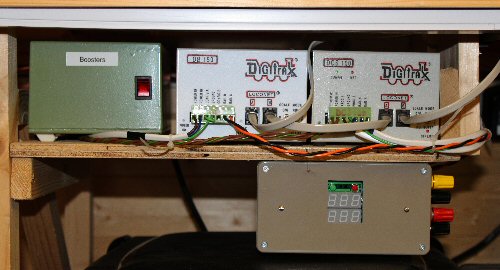This section describes how DCC has been used to control the railway. This was not, really, a controversial decision. I'm a techie; the railway is new; and it is large requiring control of tens of track sections. DCC was an obvious choice to me; I recognise that it isn't right for everyone.
But DCC is just the beginning: there's a lot more to control of this railway than just DCC. The power is sectioned into zones, with power management - this means that a short in one area doesn't remove power everywhere (DCC can be a blunt instrument in that regard). The track has occupancy detection, so that "the system" knows what track sections have trains in them. The points are DCC controlled - that isn't terribly unusual nowadays. The signals are (or will be) fully automatically controlled: that means a signal will go red when a train drives past it with no human or computer intervention. If the track ahead is blocked by a point set against it - the signal is red. If the signal in front is red, the one behind is orange; again all with no intervention.
The thing that enables all of this to happen isn't DCC. DCC itself plays its part, but it is only a component of a successful system. The real enabler is the command bus and its accessories. This is a Digitrax system, with LocoNet as the command bus and accessories from CML Electronics. The combination makes a very powerful system!
